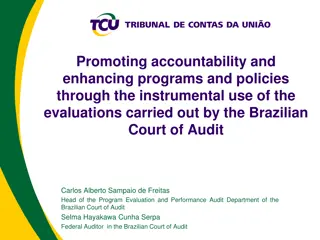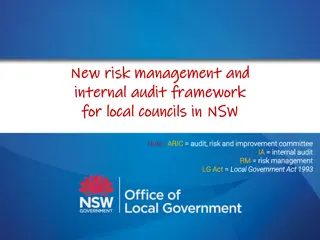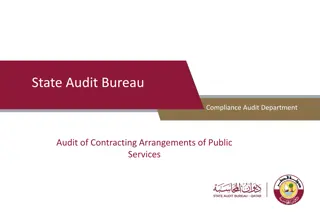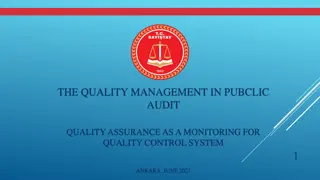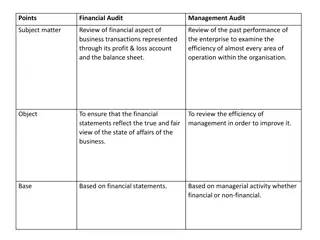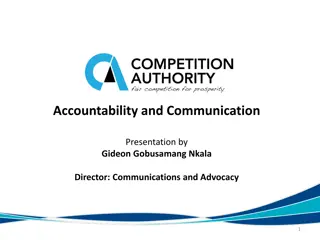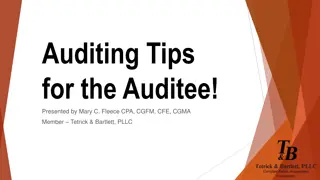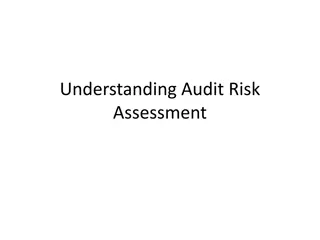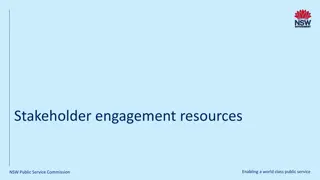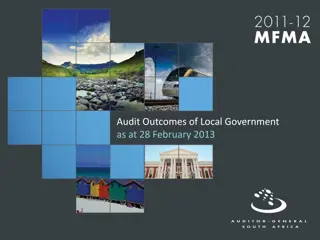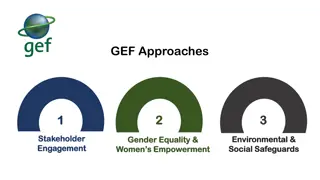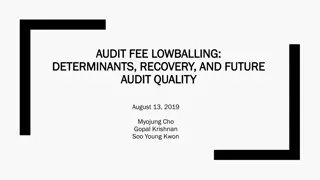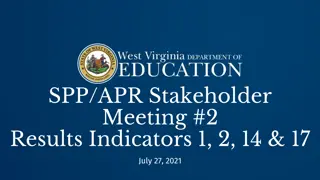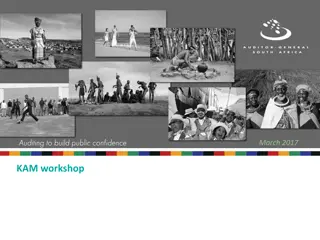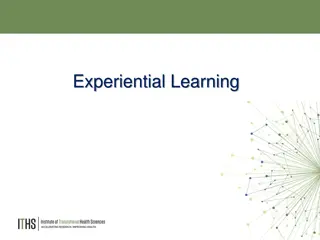Enhancing Public Accountability Through Stakeholder Engagement in Audit Processes
Social audits involving stakeholders play a vital role in ensuring public accountability. While Supreme Audit Institutions (SAIs) traditionally focus on government processes, collaboration with citizens and civil society groups can lead to more effective oversight. Various levels of interaction exist, from informing citizens to forming partnerships. SAIs can benefit from actively engaging stakeholders, gathering insights, and fostering transparency in audit activities.
Download Presentation

Please find below an Image/Link to download the presentation.
The content on the website is provided AS IS for your information and personal use only. It may not be sold, licensed, or shared on other websites without obtaining consent from the author. Download presentation by click this link. If you encounter any issues during the download, it is possible that the publisher has removed the file from their server.
E N D
Presentation Transcript
Background SAI audit remains a Government process largely confined to Government officials and Government auditors. Social audit, on the other hand, is the audit of a program or a scheme by the community with active involvement of the primary stakeholders in the process. Further, despite the joint physical verifications and beneficiary surveys undertaken by SAIs, the actual verification of outputs and outcomes has been only of secondary focus. The prime reason for this is SAI s evidence requirements constraints. as well as manpower
Engagement of stakeholders by SAIs As the ultimate beneficiaries of public funds, citizens are the most important stakeholders of SAIs. Citizens and civil society organizations (CSOs) have first-hand experience of the problems that arise in public administration. This unique position makes them not only stakeholders but also a rich source of knowledge and information about government performance and management.
Engagement of stakeholders by SAIs Some SAIs have successfully collaborated with citizens and civil society groups to improve public accountability. Overview of examples and innovations in the engagement of accountability processes by Supreme Audit Institutions. citizens in public
Levels of interaction There are three types of interaction between SAIs and citizens: (A) a one way SAI-citizen relationship where SAIs inform the citizens; (B) a two-way relationship where SAIs consult citizens; and (C) a partnership between SAIs and citizens. Not surprisingly, most of the countries inform and consult citizens, but keep them away from decision-making processes through partnership. Only a few countries fall into the C category.
Levels of interaction A typical type 'A' SAI responds to inquiries, received through its website or postal mail, and gives public speeches to educate citizens. It distributes audit reports through its website, media, conferences, and on individual request. Finally, type A SAIs fear that its independence will be compromised by engaging with citizens, soliciting their complaints, or allowing them to participate in audit processes.
Levels of interaction Type 'B' SAIs encourage citizens to contact them and they regularly conduct public opinion surveys. They also rely on focus group activities in order to gain a community perspective for example, for performance audit purposes. SAI also consults a significant number of advisory groups organisations, made up of citizens, from a broad range of disciplines. and professional
Levels of interaction SAIs of type 'C' are much fewer in number. They use every media channel, make disclosures under their right to information legislation and link-up with social accountability mechanism. Surprisingly, most of them are SAIs of developing countries where governments worried about the level of corruption in the political environment. Although it is encouraging to see that a large number of SAIs, from types 'B' and 'C', do actually take into account citizens concerns, it is also evident that an adequate platform for citizens commitment should be created in order to ensure their active role and to protect their interests. themselves are
The Netherlands Court of Audit NCA gathers knowledge and insights from citizens on the internet. Twitter is now being used to announce new NCA reports and to direct Twitter users, interested in audit issues, to their website. Occasionally, the NCA responds to Tweets from third parties, about the audit reports.
SAI Russian Federation Modalities of communication interviews of members of the Collegium; publishing in the media articles by representatives of the Accounts Chamber, broadcasting speeches by members of the Collegium on TV; answering citizens letters and appeals, establishing direct contacts with people during trips around the country;
SAI Poland Media is the main source of information for citizens. Greater cooperation with journalists is key to effective communication with citizens and obtaining their opinion. Eminent journalists have been engaged by the SAI to determine the citizens main interests in government financial accountability issues. Journalists are in touch with the people and ask them to identify the major elements of poor governance. Issues raised by citizens are then communicated and examined by the auditors. This cooperation with the media has helped SAI Poland to remain informed about citizens current concerns.
SAI Mexico Mechanisms like website, mailboxes etc. are in use to take inputs in their audit planning. Programs in the form of twenty half hour round table discussions known as Checks and Balances were moderated by a respected journalist and included the participation of specialists, scholars, members of the SAI itself and lawmakers. Fundar a research and identified large-scale corruption in a contract awarded to a private agency for an HIV/AIDS prevention program. SAI audit corroborated Fundar s findings. Resulted in government proceedings to recover misappropriated funds and changes in the policies governing the management of discretionary funds, including the HIV/AIDS prevention program. advocacy organization
SAI USA Advisory groups and professional organizations advise on topics such as strategic planning, auditing standards, and other audit issues. Direct citizen involvement for through the use of citizen focus groups and surveys. The most important mechanism in place to receive citizen complaints is a program called FraudNet, which is a vital part of the Forensic Audits and Investigative Team at the Government Accountability Office (GAO). It enables citizens to report allegations of fraud, waste, abuse, or mismanagement of federal funds anonymously through a variety of mechanisms, including e-mail, a Web page, toll-free phone number, and fax.
SAI Honduras SAI Honduras has the legal structure which requires citizens complaints to be dealt with. The process involves the organisation of a seminar- workshop with social organizations and citizens that seek to detect irregularities in public officials use and management of state assets and resources. The Department of Control and Follow up of Citizen Complaints (DCSD) is responsible for investigating the allegations raised by citizens and their follow-up in collaboration with the auditors.
SAI Argentina In Argentina, the Civil Association for Equality and Justice (ACIJ) a human rights organization successfully filed a lawsuit to obtain the minutes of the hearings of the congressional commission responsible for reviewing the SAI s public audits and initiating action recommendations. ACIJ used these records commission s lack of action in requiring corrective actions in response to audit recommendations. based on audit to highlight the
SAI Oman In Oman, the Audit Institution has detected several irregularities since its started. It was launched in a move to open communication with the community, to protect public money and to ensure better quality of services provided by entities under its supervision. Public complaints and feedback being recorded, handled and monitored, giving the assurance that the feedback is taken seriously. smart-phone application
SAI South Africa In South Africa, the Public Service Accountability Monitor (PSAM) a research organization works closely with the legislature to track government agency s responses to instances of financial misconduct and corruption identified in the auditor general s reports. PSAM highlighted the large number of audit disclaimers issued by the provincial audit agency which was unable to access financial information during its audit and led a public campaign This resulted in strengthening financial management practices within provincial government agencies. and advocacy
SAI Philippines Participatory audit was successfully conducted in 2002 as a joint undertaking of the national Commission on Audit and NGO called the Concerned Citizens of Abra for Good Government (CCAGG). CCAGG specializes in monitoring infrastructure projects within its province and uses local monitors (volunteers drawn from the area) to verify that road construction projects are executed according to contract norms. In another instance, COA is cooperating with another NGO, Procurement Watch, Inc., procurement documents of agencies that it is auditing to examine corruption in procurement processes. by providing access to
SAI Philippines In 2012, the Citizen Participatory Audit (CPA) project was officially launched to foster COA and CSOs conducting joint audits of government projects to make government more transparent, accountable and effective. Through the CPA, audits are conducted with citizen representatives included in the team to educate citizens about the audit process and encourage participation in exacting government accountability. The audit is under the direct supervision and control of the COA. Ordinary citizens were trained and officially designated as auditors themselves.
SAI Korea Inputs of civil society in planning the audits and sharing the results of audit with the public. Apart from an Audit Committee (akin to Audit Advisory Board) for the Chairman, the BAI has separate policy advisory committees for each of its functional areas. The BAI also has a system of notifying the citizens, in advance, of the scope and timing of planned audits, and considered in finalizing the audit reports. Policy Advisory their inputs are
SAI Korea National citizen audit request system to allow citizens to request special audits on public agencies suspected of corruption or irregularities. Applications are made under this system to a Citizens Audit Request Screening Committee, comprising citizens and audit officials who screen requests to identify frivolous complaints requests merit a full audit. Concerned Citizens for Economic Justice (CCEJ) routinely uses this system to request government audit of public projects plagued with corruption or resulting in waste of resources. and decide which
Challenges and constraints Concerns about the nature of collaborative practices. For example, SAIs generally have a mandate to report to legislators but not to the public. Audit systems themselves are not normally geared toward citizen participation Use of technical jargon the public is not given an opportunity to offer input on the findings in legislative hearings. Further, audit institutions may fear that their neutrality may be collaboration with civil society organizations and therefore compromise opinion. compromised through their independent audit
Challenges and constraints Audit institutions typically have not developed processes for selecting partners from among civil society organizations. For their part, civil society organizations are concerned that governments may come to develop corrupt or unseemly relationships with CSOs, if there is no system of checks and balances on their participation in audits. Any government-initiated participatory audit scheme that involves the selection of NGOs or experts from civil society is in danger of being misused.
Strengthening Collaboration between SAIs and Civil Society The procedure for selecting civil society partners could be made transparent to address concerns that governments may co-opt the partners that it selects. One such measure would independent board akin to the South Korean Citizen Audit Request Screening Committee that could act on behalf of the government to select the appropriate organizations to partner with audit institutions. involve creating an
Way forward The inclusion of citizens/CSOs in the audit process must be based on relevant legal stipulations pertinent audit standards clear practice guidelines. It also requires multi-type, but relatively fixed channels for effective communication in order to disseminate the audit-specific knowledge among the stakeholders.






